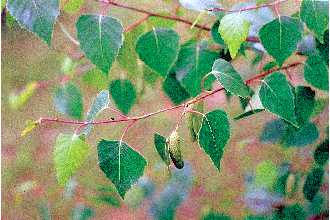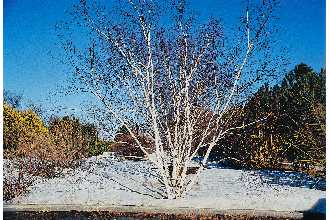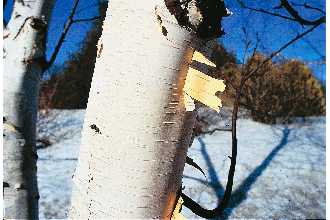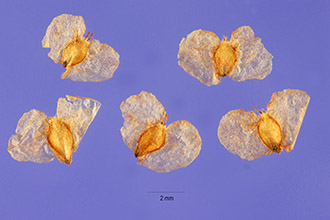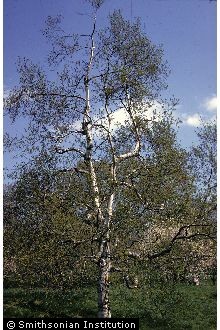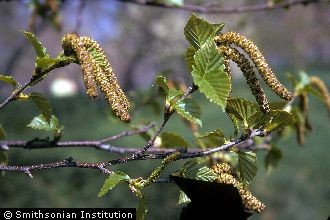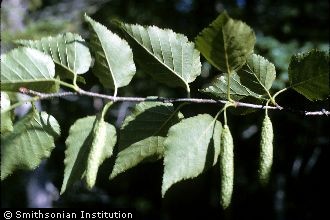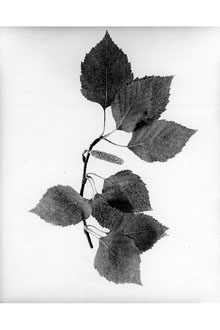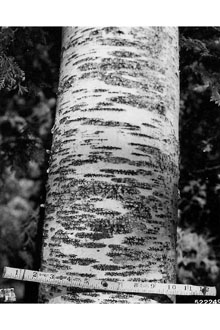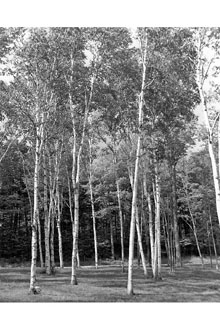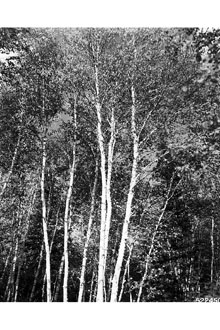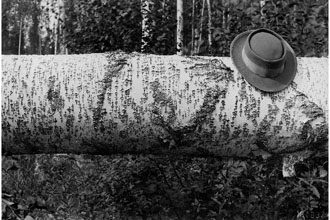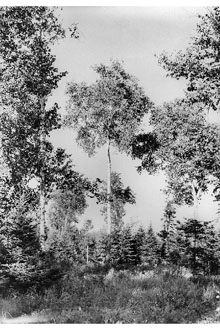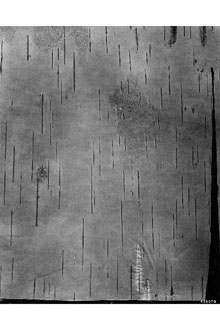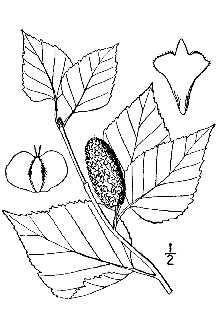Paper Birch
Scientific Name: Betula papyrifera Marshall
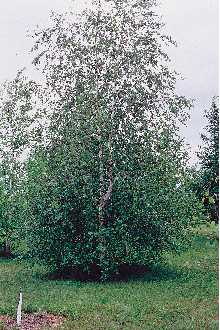
| General Information | |
|---|---|
| Usda Symbol | BEPA |
| Group | Dicot |
| Life Cycle | Perennial |
| Growth Habits | Tree |
| Native Locations | BEPA |
Plant Guide
Alternative Names
White birch (B, p, var, Use soil moisture sensors to measure the soil moisture of Paper Birch., paperifera), paperbark birch, silver birch, canoe birch; western paper birch (B, p, var, commutata), mountain paper birch (B, p, var, cordifolia), Kenai birch (B, p, var, kenaica)
Uses
Ethnobotanic: The sap and inner bark is used as emergency food (MacKinnon & Pojar 1994). White birch can be tapped in the spring to obtain sap from which beer; syrup, wine or vinegar is made. The inner bark can be dried and ground into a meal and used as a thickener in soups or added to flour used in making bread. A tea is made from the root bark and young leaves of white birch. The Shuswap made soap and shampoo from the leaves (MacKinnon, Pojar, & Coupe´ 192). It is also used by native Americans to make canoes, buckets, and baskets. The Shuswap were noted for their beautiful birch bark baskets (Ibid.). North American Indian tribes used white birch to treat skin problems of various rashes; skin sores, and burns (Moerman 1998). The bark has been used to make casts for broken bones. Economic: White birch wood is used commercially for pulpwood, plywood, veneer, and turnery. Tree chips are used for paper manufacture and fuel. Paper birch in the foreground with larch in the background. © A.V. Lozhkin Atlas of Beringia National Oceanic & Atmospheric Administration Medicinal: A decoction has been used to treat dysentery, various diseases of the blood, induce sweating, and to ensure an adequate supply of milk in nursing mothers (Moerman 1998). Birch gum could have been medicinal for some stone-age gathers. The chewable gum contains zylitol, a disinfectant, and some terpenes, which could give the chewier a mild buzz (MacKinnon & Pojar 1994). Landscaping & Wildlife: Betula papyrifera is commonly used as a landscape tree for it’s striking coloration. It is a desirable ornamental to be planted around homes and public buildings, in parks, and on campuses. Moose, snowshoe hare, and white-tailed deer browse paper birch. Numerous birds and small mammals eat the buds, catkins, and seeds. Agroforestry: White birch is used in forested riparian buffers to help reduce stream bank erosion, protect aquatic environments, enhance wildlife, and increase biodiversity.
Status
Please consult the Plants Web site and your State Department of Natural Resources for this plant’s current status, such as, state noxious status and wetland indicator values.
Description
General: Birch family (Betulaceae). White birch is a deciduous small to medium sized native tree. The leaves are alternate, ovate or triangular, five to ten centimeters long. The flowers are male and female flowers in separate catkins two to four centimeters long, the catkins break up at maturity (MacKinnon & Pojar 1994). The fruits are mature seed catkins that are three to five centimeters long. The bark is thin, smooth, dark red to almost black on young stems, becoming reddish-brown and then bright creamy white (Farrar 1995). Distribution: White birch is native in Northern North America. It is widely distributed from northwestern Alaska east across Canada to Labrador and Newfoundland, south in northwestern states to Pennsylvania and Iowa and in the western states to Montana and northeastern Oregon (Viereck & Little & 1972). For current distribution, please consult the Plant profile page for this species on the PLANTS Web site.
Adaptation
White birch is adapted to a variety of soils. It grows best in well-drained acid, sandy or silty loam, in cold soil temperatures and ample moisture. It is not tolerant of drought, compacted soils, or areas with high air temperatures. This species grows best in full sunlight and is very shade intolerant. It does not perform well in harsh conditions or heat and is not tolerant of pollution.
Establishment
Propagation from Seed: Propagation by seed requires that the seed is best sown as soon as it is ripe. Sow the seeds in containers or seed trays containing a seed germination medium to which a slow release fertilizer is added. Firm the medium and sow the seed thinly and evenly on top, and cover with medium to a depth of medium (Heuser 1997). Place the pots in a sunny location in a cold frame. Plant seedlings into their permanent positions in late spring or early summer. When seedlings are large enough to handle they should be placed into individual pots and grown in a cold frame for their first winter.
Management
Fertilization and irrigation should be done to maintain white birch vigorous condition and to help prevent borer infestation. Don’t prune this birch or other birches until summer because they are “bleeders” and should not be cut when the sap is flowing. White birch is susceptible to bronze birch borer and birch leaf minor. Cultivars, Improved and Selected Materials (and area of origin) Readily available at nurseries. Contact your local Natural Resources Conservation Service (formerly Soil Conservation Service) office for more information. Look in the phone book under ”United States Government”. The Natural Resources Conservation Service will be listed under the subheading “Department of Agriculture.”
References
Barnes, B.V. & W.H. Wagner, Jr. 1981. Michigan trees. The University of Michigan Press, Ann Arbor, Michigan. Britton, N.L. 1908. North American trees. Henry Holt & Company, New York. Dirr, M.A. 1997 Dirr’s hardy trees and shrubs: an illustrated encyclopedia. Timber Press, Portland, Oregon. Dirr, M.A. 1990. Manual of woody landscape plants: their identification, ornamental characteristics, culture, propagation, and uses. 4th ed. Stipes Publishing Co., Champaigne, Illinois. Great Plains Flora Association 1986. Flora of the great plains. University Press of Kansas, Lawerence, Kansas. Farrar, J.L. 1995. Trees of the northern United States and Canada. Iowa State University Press, Ames, Iowa. Heuser, C.W. 1997. The complete book of plant propagation. The Taunton Press, Newtown, Connecticut. Viereck, L.A. & E.L. Little, Jr. 1972. Alaska trees and shrubs. United States Department of Agriculture, Washington, D.C. Agriculture Handbook No. 410. Pojar, J. & A. MacKinnon 1994. Plants of the Pacific Northwest coast: Washington, Oregon, British Columbia, and Alaska. Lone Pine Publishing, Redmond, Washington. Preston, R.J. Jr. 1948. North American trees. 2nd ed. The Iowa State College Press, Ames, Iowa. MacKinnon, A., J. Pojar, & R. Coupe´. 1992. Plants of the northern British Columbia. Lone Pine Publishing, Canada. McMinn, H.E. & E. Maino 1963. An illustrated manual of pacific coast trees. University of California Press, Berkeley, California. Moerman, D. 1998. Native American ethnobotany. Timber Press, Oregon. National Oceanic & Atmospheric Administration 1999. Paleoenvironmental atlas of Beringia. Accessed: 11jan02. <http://www.ngdc.noaa.gov/paleo/parcs/atlas/beringia/vphotos.html> Preston, R.J. Jr. 1989. North American trees. 4th ed. Iowa State University Press, Ames, Iowa. Sargent, C.S. 1961. Manual of the trees of North America. Vol. 1. Dover Publications, Inc., New York, New York. Weber, W.A. 1990. Colorado flora: eastern slope. University Press of Colorado, Niwot, Colorado.
Plant Traits
Growth Requirements
| Temperature, Minimum (°F) | -62 |
|---|---|
| Adapted to Coarse Textured Soils | Yes |
| Adapted to Fine Textured Soils | Yes |
| Adapted to Medium Textured Soils | Yes |
| Anaerobic Tolerance | Low |
| CaCO3 Tolerance | Low |
| Cold Stratification Required | Yes |
| Drought Tolerance | Low |
| Fertility Requirement | Medium |
| Fire Tolerance | High |
| Frost Free Days, Minimum | 80 |
| Hedge Tolerance | Low |
| Moisture Use | High |
| pH, Maximum | 7.4 |
| pH, Minimum | 4.2 |
| Planting Density per Acre, Maxim | 700 |
| Planting Density per Acre, Minim | 300 |
| Precipitation, Maximum | 60 |
| Precipitation, Minimum | 12 |
| Root Depth, Minimum (inches) | 24 |
| Salinity Tolerance | Medium |
| Shade Tolerance | Intolerant |
Morphology/Physiology
| Bloat | None |
|---|---|
| Toxicity | None |
| Resprout Ability | Yes |
| Shape and Orientation | Erect |
| Active Growth Period | Spring and Summer |
| C:N Ratio | Medium |
| Coppice Potential | Yes |
| Fall Conspicuous | Yes |
| Fire Resistant | No |
| Flower Color | Yellow |
| Flower Conspicuous | Yes |
| Foliage Color | Green |
| Foliage Porosity Summer | Moderate |
| Foliage Porosity Winter | Porous |
| Foliage Texture | Medium |
| Fruit/Seed Conspicuous | No |
| Nitrogen Fixation | None |
| Low Growing Grass | No |
| Lifespan | Moderate |
| Leaf Retention | No |
| Known Allelopath | No |
| Height, Mature (feet) | 70.0 |
| Height at 20 Years, Maximum (fee | 40 |
| Growth Rate | Rapid |
| Growth Form | Single Stem |
| Fruit/Seed Color | Brown |
Reproduction
| Vegetative Spread Rate | None |
|---|---|
| Small Grain | No |
| Seedling Vigor | Medium |
| Seed Spread Rate | Rapid |
| Fruit/Seed Period End | Summer |
| Seed per Pound | 1380800 |
| Propagated by Tubers | No |
| Propagated by Sprigs | No |
| Propagated by Sod | No |
| Propagated by Seed | Yes |
| Propagated by Corm | No |
| Propagated by Container | Yes |
| Propagated by Bulb | No |
| Propagated by Bare Root | Yes |
| Fruit/Seed Persistence | Yes |
| Fruit/Seed Period Begin | Summer |
| Fruit/Seed Abundance | High |
| Commercial Availability | Routinely Available |
| Bloom Period | Mid Spring |
| Propagated by Cuttings | Yes |
Suitability/Use
| Veneer Product | Yes |
|---|---|
| Pulpwood Product | Yes |
| Protein Potential | Low |
| Post Product | No |
| Palatable Human | Yes |
| Palatable Browse Animal | High |
| Nursery Stock Product | Yes |
| Naval Store Product | No |
| Lumber Product | No |
| Fuelwood Product | High |
| Fodder Product | No |
| Christmas Tree Product | No |
| Berry/Nut/Seed Product | No |

